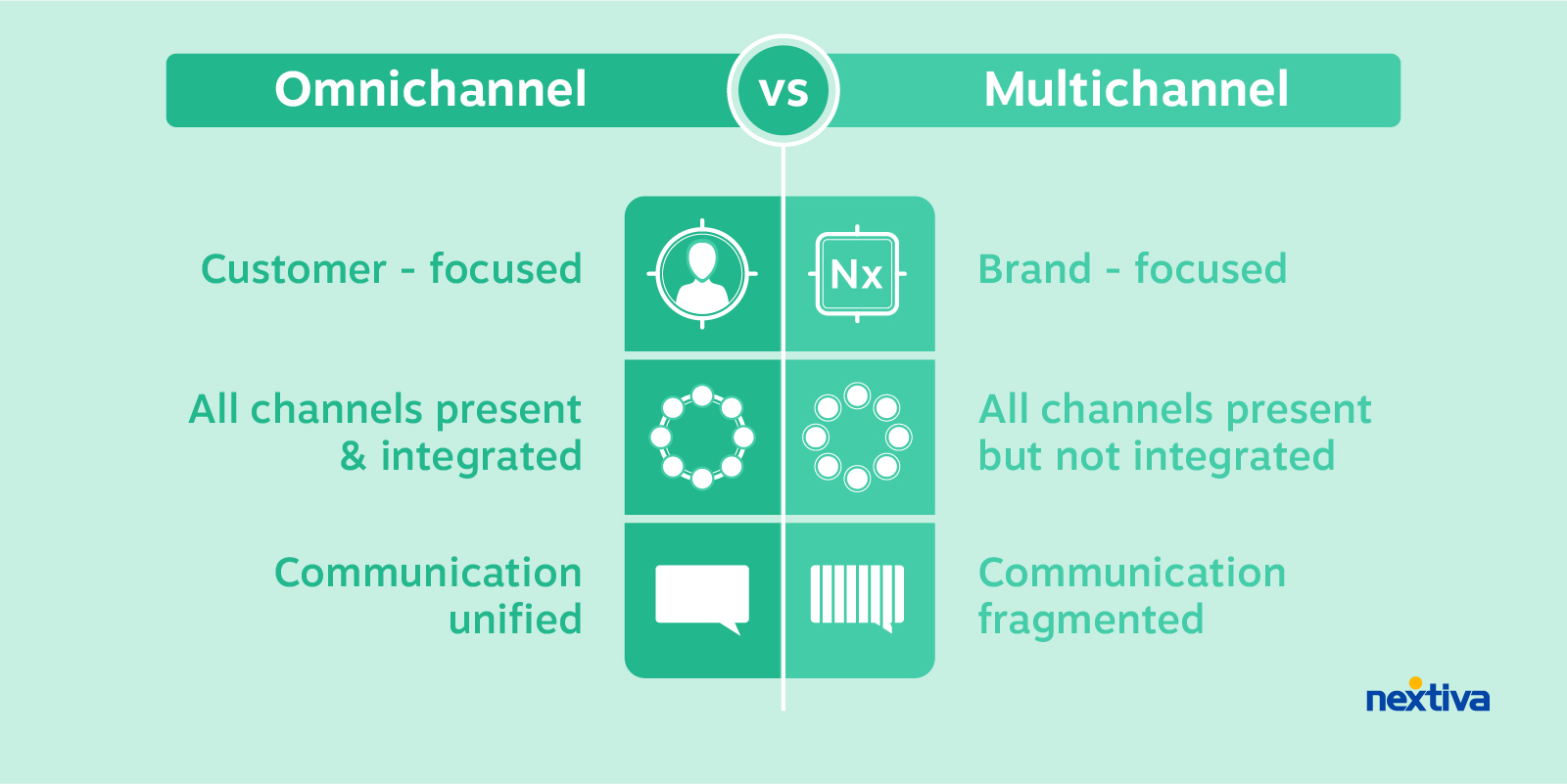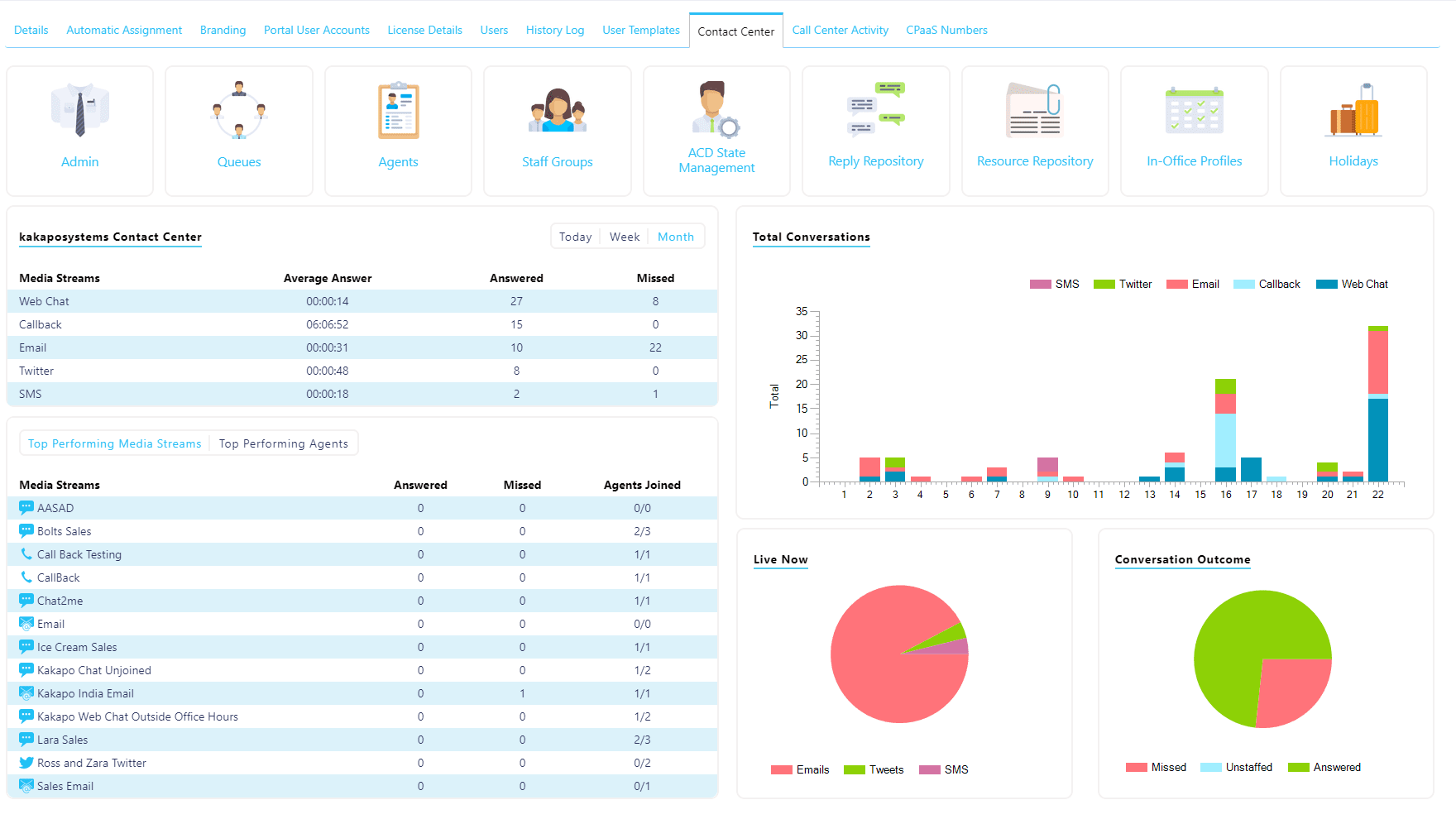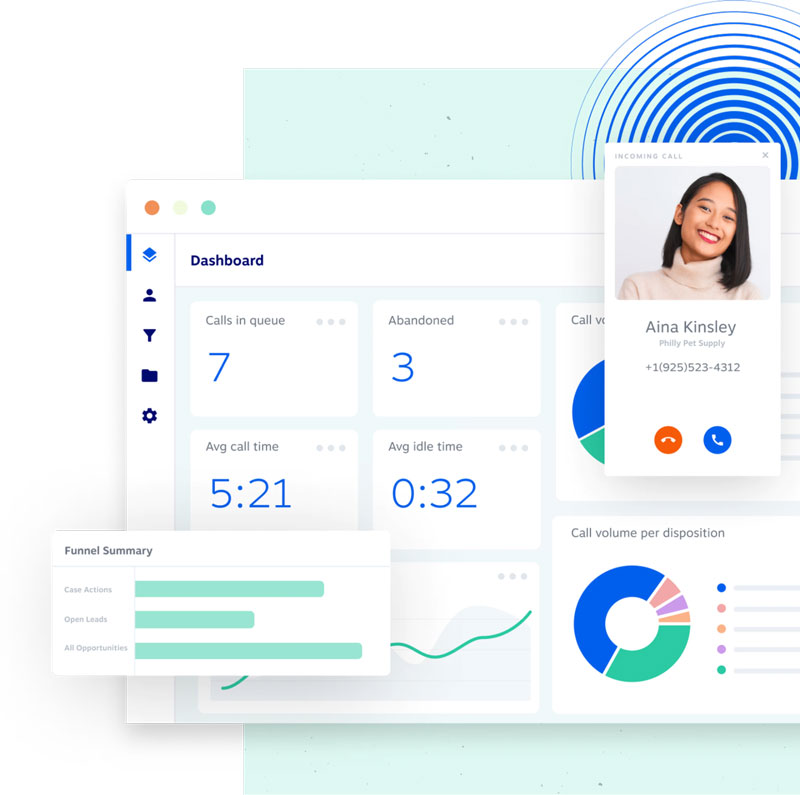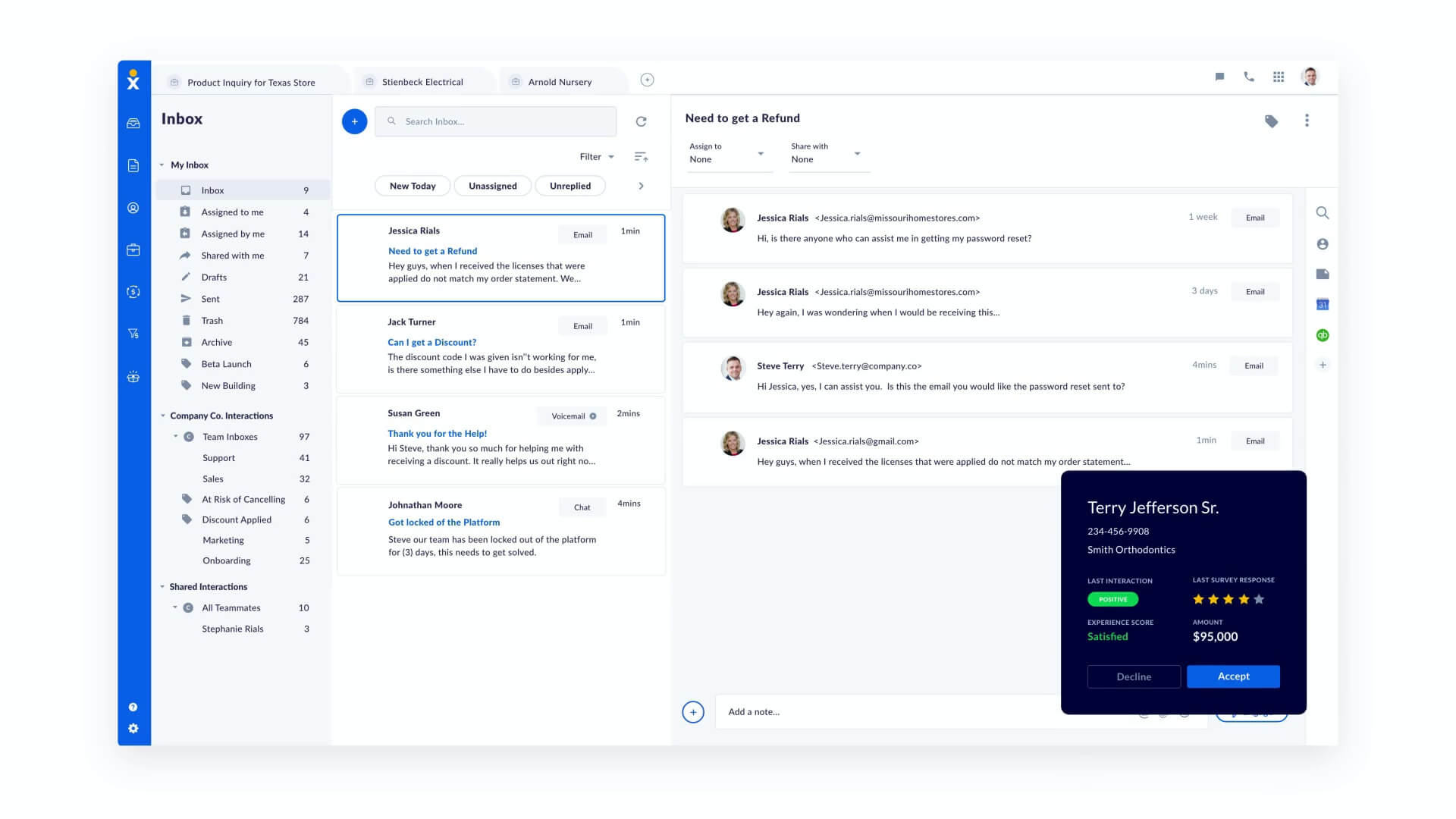People no longer rely on the phone to receive customer service. Despite voice being the top medium to seek customer support, there are numerous channels to get help today.
Now, companies have omnichannel demands to be responsive across the phone, email, video, SMS, social media, and live chat.
We’ll explain everything to know about omnichannel contact centers, including why they’re used, top features, and best practices.
What Is an Omnichannel Contact Center?
An omnichannel contact center is cloud-based software that unifies customer interactions across multiple channels into one interface. These channels encompass phone calls, chats, emails, text messages, social media, and others. Support representatives can see every customer interaction on a single dashboard, so customers don’t have to repeat themselves.
An omnichannel contact center consolidates several contact channels into one platform. And customers love it. According to Aberdeen Group, companies adopting an omnichannel strategy saw a 91% increase in customer retention year-over-year than those without!
There’s one undeniable truth: If people must find you, they’re going to find someone new.
Omnichannel Customer Experience Example
Here’s an example to show you how an omnichannel cloud contact center works in practice.
Let’s say a customer is dealing with a technical issue. They’ve read a few self-service help docs but have hit the point where they need help.
Their first stop is your website’s chat to explain the issue. But after some back and forth, they decide to call in to “talk to a real person.”
An omnichannel customer experience solves this problem. This way, when that customer calls customer support, live agents already have:
- Customer behavior data, including past interactions
- Transcripts of their previous chat conversations and video calls
- Recent touchpoints, such as self-service options they attempted
Rather than making customers repeat themselves, your contact center agents start with a holistic view of every customer interaction and can pick up right where their colleagues left off.
This sort of unified communication isn’t easy. But it’s what your customers expect.
Research from McKinsey shows that most customers engage with three to five different channels to resolve a request. In addition, 86% of customers expect conversations to move seamlessly between omnichannel customer service channels.
Related: What Is a Contact Center? Definition, Features, and Uses
Get a cloud contact center solution from Nextiva.
IVR, call recording, VoIP numbers, call routing, advanced reporting–integrated in ONE cloud platform.
Omnichannel vs. Multichannel Contact Centers
You’re probably familiar with handling support requests across multiple service channels. Contact center providers have been adding new channels for years, leading to people describing them as multi-channel because it works across multiple communication paths.
Here’s a quick comparison between a multichannel and omnichannel contact center.
| Functionality | Multichannel contact center | Omnichannel contact center |
|---|---|---|
| Supports multiple channels | ✔ | ✔ |
| Seamlessly switch between communication channels | ✗ | ✔ |
| CRM integration for relevant customer data | ✗ | ✔ |
| Real-time insights on customer activity | ✗ | ✔ |
| One team can handle requests across all channels | ✗ | ✔ |
However, a few significant features separate a multichannel approach from an omnichannel one.
Different channels are managed by separate teams in a multichannel contact center. This means real-time customer interaction history isn’t updated as they transcend from one medium to the next. When customers move from a call to chat, they’re essentially starting over.
On the other hand, the omnichannel approach combines all your communication channels, customer history, and data into one consistent experience. Customers can use their preferred channel without repeating themselves. Contact center agents can gracefully handle each topic using centralized contact center software.
Beyond the lack of features, there are a few downsides to a multichannel contact center as compared to an omnichannel one:
- Multichannel contact centers provide a worse customer experience. Customers must repeat themselves when switching messaging channels. They also don’t get the personalized experience they crave today.
- Multichannel contact centers can be more expensive to run. When customers need to make several requests for one issue, companies need to hire more customer service agents. On the other hand, Omnichannel pricing includes many more capabilities for the same price (e.g., intelligent VAs, workforce management, smart IVRs, conversational AI, etc.).
- Multichannel contact centers could harm customer engagement. Numerous customer service stats indicate that consumers would switch companies after a single poor experience. What will your existing omnichannel call center cost you?
More channels don’t create a better customer experience. Instead, the more channels you support, the more critical an omnichannel approach becomes.

Omnichannel Contact Center Benefits
Cloud-based contact center solutions simplify complex interactions. When you streamline customer service tools, you’ll help them become more productive and effective.
But where do you start when building out an omnichannel approach?
Here are seven of the must-have features for choosing an omnichannel contact center:
1) Cloud-based with a unified interface
An omnichannel strategy works when employees can effortlessly move between channels while maintaining customer history and context.
For this to happen, your contact center software needs an easy-to-use, intuitive interface that provides real-time data for each agent.
Here are a few qualities to look for when evaluating an omnichannel contact center’s interface:
- Customer data and conversations in one place: Agents shouldn’t have to jump between screens, tools, or apps to maintain a seamless customer experience. API integrations are imperfect — strive for complete functionality without middleware.
- Cloud-based redundancy: Look for a tool that manages all your data sources and conversations in the cloud. The cloud keeps all your CRM organized and allows agents to work from home comfortably.
- Quick access to real-time data: Agents should have access to customer insights, past interactions, and customer satisfaction scores to deliver the best experience possible.
2) Seamless integration between channels
Customer expectations change rapidly. A few years ago, most people wouldn’t use a chatbot to answer their questions; today, 74% of customers prefer them for quick answers.
An omnichannel contact center must be scalable and agile enough to integrate with any new channel that comes to the market without downtime or changing workflows.
Here are a few questions to ask when evaluating how your omnichannel contact center will handle integrations:
- What other tools integrate with this contact center? Look for integrations with your customer CRM and every communication channel you use, such as predictive dialers and digital channels like email, SMS, and social media.
- How are integrations displayed in the interface? Look for contact center software that reduces friction by bringing cross-channel conversations together into a single view. Agents shouldn’t need to bounce between screens to keep the conversation moving.
- Is it easy to share data or merge reports across channels? Look for reports that prioritize customer experience rather than a specific channel. For example, the first response time is preferred to the first email response time. It’ll help you with forecasting and workforce optimization.
3) Customer insights render personalized experiences
Your customers are unique in how they use your product and seek help. Some customers enjoy using self-service options like a knowledge base. The preferred channel to solve a significant issue is the phone, email, and social media.
The more access agents have to information, the better equipped they’ll be to handle requests.
A communications platform like one from Nextiva pulls all your customer data into one place. This capability means your team can see interaction history, account value, and satisfaction during conversations.
Here are some customer insights your omnichannel contact center should include:
- Customer info: Name, company, alternative contact info, and open or closed tickets can help you personalize the interaction.
- Interaction history: A list of conversations across all channels and a brief rundown of their outcomes.
- Real-time insights: Product pages, help docs, or features they recently used to add context to the issue.
- Account value metrics: Customer value, trending satisfaction, and survey results. Support agents should instantly know they’re assisting a high-value account.
4) Intelligent routing of inbound requests
With more channels, proper routing becomes crucial. A seamless customer experience means connecting customers to the right agent the first time around.
Look for a contact center solution that offers intelligent routing features such as:
- Automatic call distribution (ACD): Route inbound calls to the right person or team depending on history, time, or support level.
- Deep CRM integration: Leverage your existing customer data to direct customers to the right agent or department. These surface actionable insights across the entire customer journey.
- Conversational AI: Respond to customers seeking help with answers based on artificial intelligence. Select omnichannel contact center solutions that leverage AI and natural language processing to pick up on real-time sentiment.
5) Integrated data across the customer journey
The only way to execute a seamless omnichannel experience is to gather data along each customer touchpoint. As people shift from social media to chat to phone calls, their history should reflect each customer interaction.
Here are a couple of data-focused features your omnichannel contact center should support:
- Insights into the customer journey: See where your customers came from and what channels they used to connect. Examples of these contact methods include a mobile app, email, or SMS.
- Track and analyze your entire pipeline: Understand customers’ steps throughout their business relationship. Add or subtract “points” depending on the intent and outcome.

6) Performance management and reporting
An omnichannel contact center can give managers deep insights into their team’s performance. Instead of trying to streamline metrics or reports across several tools, everything is in one place.
Here are a few essential analytics tools that your contact center should include:
- Historical and daily data trends: Contact center leaders should see at a glance where agents and processes need to improve. Most call center solutions offer this out of the box.
- Customizable KPIs and goals: What’s most important to you? Speed of answer? CSAT score? Identify which ones reflect your customer’s needs and business drivers.
- Agent dashboards for coaching: Reporting should be empowering and actionable for both call center agents and managers. Adopt team-based wallboards to drive awareness and friendly competition.
7) Enterprise-grade security and reliability
Finally, security and uptime are critical when a single tool handles all your customer data and support channels. For example, Nextiva’s network has the industry’s highest uptime, which means you can be there for your customers.
Your omnichannel solution is up to the task if it:
- Meets stringent industry standards such as PCI, SOC 2, or HIPAA
- Maintains a status page with updates on past events and planned maintenance
- Undergoes regular security audits and 24/7 monitoring
In the age where data breaches and outages can happen to almost anyone, you can’t afford to go with the bare minimum. You need a proven leader to power your communications.
Related: Enterprise Contact Center Solutions: Overview & Key Features
Features to Look for in an Omnichannel Contact Center
When looking into an omnichannel contact center solution, keep these features in mind.
- Cloud-based deployment — Ensure all team members can securely access and manage the contact center platform regardless of location, including those who work from home.
- Intelligent case routing — Routes inbound calls and case topics to the right agents and workflows to achieve customer satisfaction.
- Unified agent tools — Enables team members to work using a familiar, unified dashboard to manage calls, cases, and tickets without switching tools.
- Integrates with business applications — Connects the data found between your customer data platform, including CRM, marketing, sales, and self-service support software.
- Robust analytics and reports — Simplifies and improves the fidelity of contact center reports in a reliable way across all contact methods, such as email, web, phone, SMS, and social media.
Omnichannel Contact Center Best Practices

Embracing an omnichannel strategy means defining a cohesive vision to optimize the customer service experience. This effort results in revisiting tools, workflow automation, and customer touchpoints.
Let’s start by looking at some strategies and best practices as you move to a multichannel environment.
1) Build more personalized experiences
Personalization is at the core of the omnichannel approach. According to Microsoft’s research, 72% of people expect your customer service team to know who they are, what they’ve purchased, and insight into their past interactions.
A unified contact center platform streamlines all this information and puts it at your agents’ fingertips. It increases agent productivity and allows you to leverage personalization to keep customers coming back.
2) Map out common customer journeys
Customers rarely take a linear path when engaging with your company. They might read a self-service knowledge base article or send a tweet before engaging with your support team.
The more you understand your customer journeys — the channels they use and their paths — the more impactful your omnichannel approach can be.
3) Be proactive about data collection
The omnichannel approach is only as good as the data you make available to your agents.
At a minimum, this includes any previous conversations the customer has had across channels. However, you can empower your support team even more by including real-time data and insights from your customer service CRM such as:
- Previously viewed pages
- Abandoned carts
- Survey results
- Upcoming renewals
- Customer value
- Social media interactions
Aim to unify segmented customer data into a consolidated CRM instead of separate data silos.
4) Monitor changes in customer preferences
If the pandemic has taught business owners anything, it’s that markets and entire industries can change overnight. You can rapidly adapt to their changing needs using an omnichannel contact center.
Examples of this could mean looking for an uptick in social media outreach or declining customer satisfaction on specific channels.
If customers grow frustrated with the limitations of an automated chatbot, offer them an easy way to reach a live agent. This way, a rep takes over for a personalized and seamless experience.
Brands should collect phone numbers in web chat. This allows agents to initiate an outbound call to squash any outstanding concerns. Plus, it provides another means for cloud contact centers to identify and track accounts.
5) Strike a balance between humans and technology
Omnichannel contact centers are powered by some of the best customer support technology. However, support quality still comes down to human interaction.
It’s great to see calls getting shorter and reps handling more issues. Yet, none of that matters if your customers are leaving unsatisfied.
Your omnichannel strategy should include vital human elements, such as:
- Be consistent across channels: An omnichannel approach means that response time and quality are channel-agnostic. Treat all channels equally.
- Make ‘customer-centric’ the core of your strategy: Balance agent effectiveness with customer satisfaction. Speed should never outshine amazing service.
- Integrate before launching a new channel: Plan how any new platform will fit into your existing omnichannel strategy and agent desktops before going live.
Related: 23 Call Center Best Practices for Superior Customer Experience
How Does a Call Center Compare to an Omnichannel Contact Center?
Several differences exist between call and contact centers, mostly around data integrations, contact methods, types of requests, and agent workflows.
This video explains the key differences in less than three minutes.
Tips to Train Omnichannel Customer Service Agents
With more contact methods and context to consider, customer service staff face increasingly complex situations.
Behind every great customer experience is a team that delivers the seamless experience customers rave about.
As you move to an omnichannel model, your team will need training. Here are a few suggestions to get you started:
- Decide on your omnichannel KPIs: Update your contact center KPIs to measure your customer experience. For example, you might want to focus on multi-channel issue resolution rather than call volume as a success metric.
- Share your strategy: Educate your team on your company’s omnichannel strategy and how it impacts them. It should yield appreciation for the customer journey and how each customer interaction influences customer success. It should also outline efforts to augment customer data to create a better experience.
- Promote real-time collaboration: Help agents find the resources they need to handle more complex requests. Since each customer touchpoint matters, empower agents to take ownership of customer issues. Leverage your cloud contact center software for messaging internal experts so customers don’t have to attempt a second or third contact.

Simple changes to how you coach your team can make a sizable impact on your omnichannel strategy. Over time, you’ll create a proven customer care playbook that spans every service channel.
The Future of Customer Support: Omnichannel
The days of a single point of contact are over.
Customers expect you to be responsive on their preferred channels. What matters most is to arm call center teams with the means to streamline multiple communication channels.
An omnichannel contact center makes it easy for customer support agents to provide exceptional customer satisfaction regardless of how customers contact them. While it may sound complicated, the results speak for themselves.
You don’t have to take on every digital channel at once. A phased approach lets you gracefully add more inbound contact methods to provide a seamless experience.
Considering that 86% of customers spend more money with companies that provide great experiences — you can’t afford to not use an omnichannel platform.



